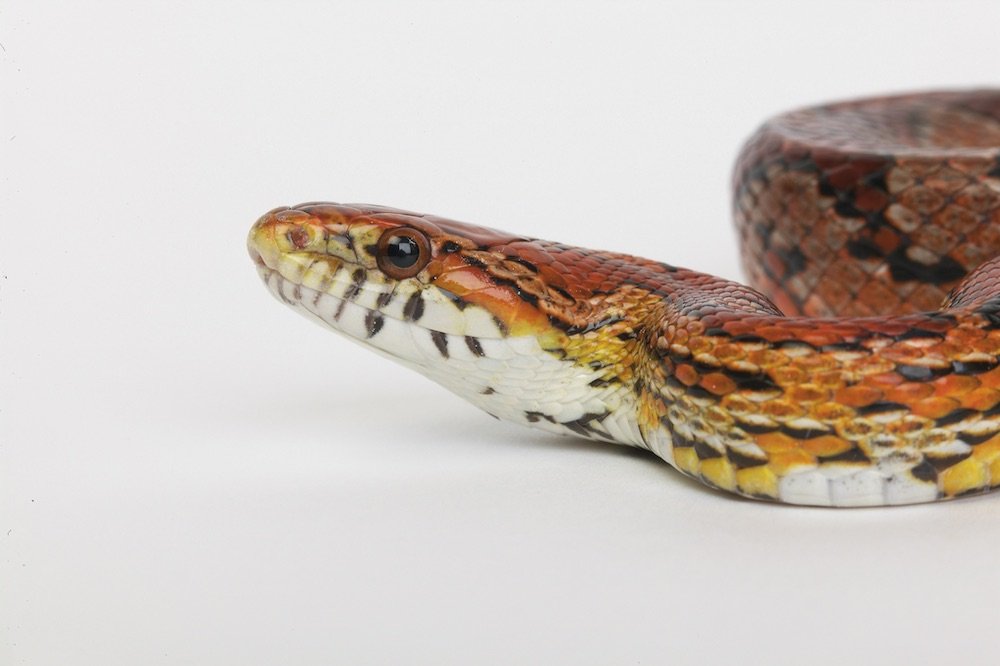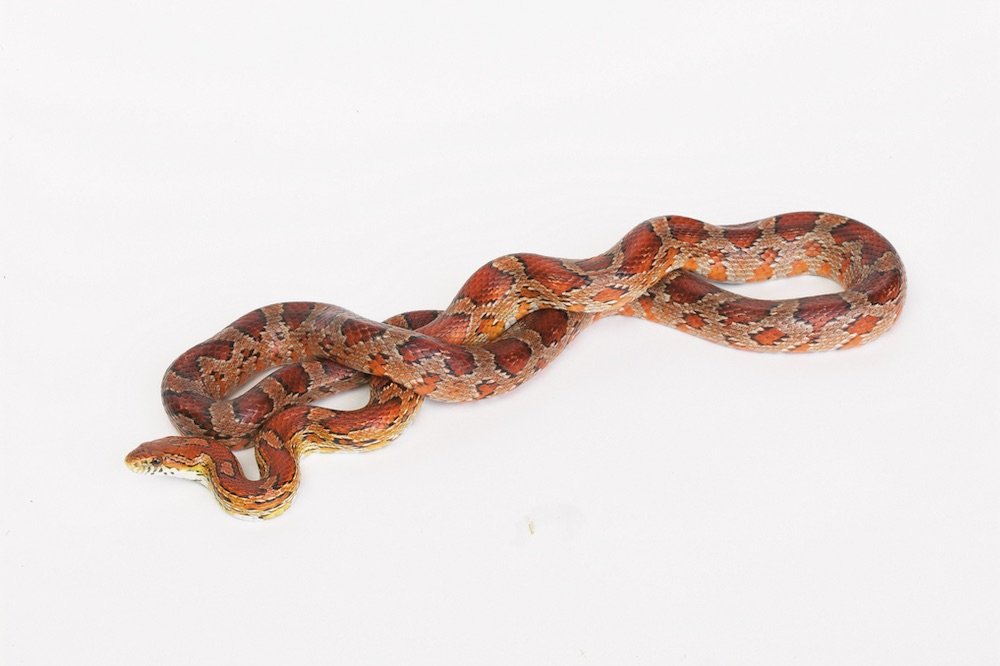
Corn snakes
Corn snakes have been bred in captivity for many generations and are now available in a huge range of different colours and patterns. With a their calm nature, manageable size and tolerance of being handled Corn Snakes are an ideal choice for a first time snake owner.
Creating the perfect environment is vital for all reptiles and owners need to allow for the expense of providing the correct heating and lighting for the whole of the animals life, and that could be 20 years or more. That’s a big commitment because although snakes may only feed every week or so they still need daily attention to make sure they stay happy and healthy.
Learn all about Corn Snake care in the test to find out if these snakes could be your ideal companion for many years to come.
What next?
View the information below to learn the essentials for owning a pet corn snake.
Take the test, and when you have passed, you will receive a certificate to show to your pet shop and prove your knowledge.
Information for owning a pet corn snake
The Pet Know How tests are designed to test your basic knowledge of keeping a pet of your choice. They will help you understand the needs of the animal and some of the important things you need to consider if you were to have one as a pet. Once you complete a test you won’t be an expert keeper but you will be in a better position to make an informed decision and decide if you are able, and willing, to take on the responsibility.
In this section, you will find a wealth of knowledge compiled by pet experts to provide you with the valuable information you need regarding owning a pet corn snake.
Work your way through all the sections, and when you feel ready, register yourself to take the test and earn a certificate that proves your corn snake knowledge.
Introduction
Corn snakes are a species of rat snake, originating from eastern United States, and are the most popular snake species kept as pets.
Adults are medium in size, easy to feed and can withstand a large temperature range. They are generally good natured and therefore ideal as a first snake, or for the experienced hobbyist, alike. They come in a vast, and increasing, array of colour morphs and all corn snakes available are captive bred.
The corn snake’s habitat varies from open wood lands to rocky hillsides and the length of an adult varies from 75cm to 200cm. Their average life span is approximately 15-20 years.
Choosing your corn snake
A healthy snake should…
Be alert and inquisitive, usually through extensive tongue flicking in new situations
Feel strong and not flaccid in your hands
Have a body cross-section that is more rounded than angular
Have a body that is symmetrical, clean, and free of swelling, unless recently fed
Have skin that appears taught and shiny (a dull or dry appearance with visible folds along the body may indicate a health issue)
Have a vent area that is clean and free of any encrustation (indicative of diarrhoea)
Move around the cage easily with no stiffness or staggering
Have no discharge from the nostrils and the mouth should be tightly closed
General care
Corn Snakes are robust animals and have few major health issues. If you have any concerns about your pet then you should consult a specialist vet.
Regurgitation: This can be caused by environmental temperature that are too low or by some diseases. In the case of repeated regurgitations then you should consult a vet.
Parasites: Captive bred corn snakes will rarely have internal parasites. Snake mites are common. These live on the skin of the snakes, as well as in the vivarium, and feed by sucking the blood of the snake. They can be treated using specific treatments available for your pet store or vet.
Poor shedding: This is usually caused by low environmental humidity and can be easily rectified by providing a suitable humid hide. It can also be caused by mites and some diseases.
Swellings & lumps: Like all animals snakes can develop growths and tumours. Any unusual lumps or swellings should be examined by a vet as soon as possible.
Respiratory problems: A possible infection is indicated by mouth gaping and/or bubbly mucus from the mouth or nostrils. Mouth gaping or inability to close neatly, due to swelling, can be indicative of mouth infections.
Your snake's eyes will become cloudy from time to time. This is not a health issue but indicates that it is about to shed its old skin. Higher humidity in the housing is useful at this time will assist the shed. Make sure you check that both eye covers are shed successfully, as sometimes the protective scale that covers the eye does not shed correctly.
Housing
A well ventilated, adequately heated, escape-proof vivarium is the best housing for your corn snake.As a minimum the vivarium should have a width of at least 80% of the length of the snake and ideally larger. Young snakes may be kept in smaller housing which can make feeding and maintenance easier, and moved into larger accommodation as they grow. There must be no gaps between glass sliding doors sufficient to allow a hatchling to squeeze through.
Corn snakes are not social animals and are best kept singularly.
Furnishing their home
There are many substrates that are suitable for use on the floor of housing for corn snakes. Loose substrates such as aspen bedding, wood chips, bark chip, coir, sand/soil mixes are preferred to allow burrowing, but some keepers choose a more sterile environment and use paper. Your pet shop can advise on the most suitable substrate for your pet. It is very important to provide hiding places in both the cooler and hotter ends of the vivarium and to ensure that the substrate under at least one hide is kept relatively moist to create a humid hide - which facilitates better skin shedding.
Piles of rocks, securely positioned slates and other such furnishings will be appreciated by your pet. Corn snakes will climb and a piece of branch can be provided for that purpose.
Lighting & temperature
UVB is not considered essential for corn snakes with a good quality diet and/or supplementation. However, UVB has many functions in a reptiles body and they are likely to benefit from the provision of UVB and it is recommended that a suitable good quality UVB reptile bulb is used.
All reptiles are “cold blooded” and need an external heat source to maintain their body temperature. One end of the vivarium should be heated to create a thermal gradient, allowing the snake to choose its preferred temperature. The ideal thermal gradient is 24-25°C at the cool end and 30-34°C at the hot end. Night temperature can be dropped by several degrees at both ends, which will benefit your pet as this reflects his natural environment, and a cooler winter period can also be beneficial.
Background heat can be provided by using heat mats which cover no more than 50% of the wall or floor area. Wall mounting is recommended but if used on the floor then great care must be taken that the mat is not thermally insulated by deep substrate or décor as this can be a fire risk. A warm basking zone can be created by using spot lights or heat lamps. All heat sources should be guarded to prevent burning and must be controlled using a suitable thermostat. Your pet shop can advise on suitable heating and temperature control products.
Thermometers should be placed at each end to monitor the temperature range and the maximum temperature of the heat gradient.
Hygiene
Vivariums should be spot cleaned, as soon as droppings are produced, and disinfected with a pet safe disinfectant occasionally. Soiled substrate should be safely disposed of and replaced with fresh.
Corn snakes should be provided with a no-tip water bowl, which is large enough for the snake to submerge in, especially when shedding its skin. This should be washed and cleaned regularly.
Handling
Corn snakes seldom bite, but do need time and patience to become accustomed to gentle handling. The snake should be held loosely and supported at the middle and rear of the body, the handler's movements being slow and deliberate.
Corn snakes can be gradually accustomed to handling by handling them gently every few days. However, avoid handling a corn snake before, during or shortly after, feeding or when the odour of its food is on your hands. Doing so may result in it mistaking your finger for food, or may cause it to regurgitate its last meal.
It is important to remember to always wash your hands before and after handling. Never attempt to handle a snake until it has settled down and is feeding regularly.
Reptiles and food for snakes can carry a form of Salmonella, which can be transferred to humans. Good hygiene and washing your hands after handling your snake should be sufficient to prevent any risk of infection.
Food and water
Corn snakes are carnivores and feed principally on mice or rats, which they consume whole. The food offered should be no larger than a maximum of one and a half times the diameter of the snake’s mid-body. Young snakes can be fed once or twice per week and adults fed every 7-14 days. Adults may fast for many weeks during the breeding season.
Frozen feed needs to be carefully thawed and warmed to blood temperature before offering to avoid stomach upsets and vomiting. It is recommended to defrost food overnight in a fridge, before warming and feeding the next day. Food should not be defrosted in a microwave or in hot water. Please see the REPTA guidance leaflet for more information.
Clean drinking water should be available at all times.
Shopping list
Owning a pet is a financial as well as a moral responsibility. In order to properly care for a corn snake the following items are essential and you should ensure that you are ready to commit to both the one-off and ongoing costs involved with having a pet.
Vivarium
Substrate
Heat bulb
Thermostat
Thermometer(s)
Suitable UVB reptile bulb
Water bowl
Hide(s)
Branches
Pet safe disinfectant
Frozen mice/baby rats
Book on corn snake care
Pet code of practice
Owning a pet is a responsibility and owners must always ensure that they act in a way that ensures the best welfare for their pet and does not endanger the local ecosystem. Pet’s (companion animals) must never be released into the wild. It is illegal and for most species this will lead to an untimely and possibly lingering death, as they are not native to this country. Any animals or plants that do survive might become harmful to the environment. If you can no longer keep your pet then seek advice at a local pet store, rescue centre or specialist pet club.
Soiled substrate, cage décor and waste water, particularly from fish tanks or amphibian housing, should also be carefully disposed of or treated so that potentially harmful diseases or live food can’t escape into the wild.
Are you ready?
Now that you have made your way through the presentation, it’s time to take the test and move one step closer to proving your knowledge and receiving your certificate.
But first…
In order to access a Pet Know How test, you first need to register some details.
Why do you need to register?
We collect limited personal data in order to personalise Pet Know How certificates, confirm participation of a Pet Know How test, record your certificate number and personalise your website experience. We do not share data with any third parties or use it for marketing. Please see our privacy policy for full details.







